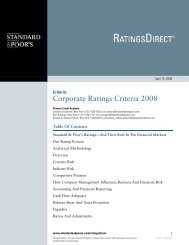European Infrastructure Finance Yearbook - Investing In Bonds ...
European Infrastructure Finance Yearbook - Investing In Bonds ...
European Infrastructure Finance Yearbook - Investing In Bonds ...
You also want an ePaper? Increase the reach of your titles
YUMPU automatically turns print PDFs into web optimized ePapers that Google loves.
PROJECT FINANCE/PUBLIC-PRIVATE PARTNERSHIPS<br />
114 ■ NOVEMBER 2007<br />
Question 12: Is the documentary and legal<br />
review for an accreting debt or swap structure<br />
different from other project finance or<br />
PPP ratings?<br />
No. The legal review across project structures is<br />
comparable, and Standard & Poor’s expects that<br />
transactions using accreting debt will have a<br />
robust legal structure. Our documentation and<br />
legal review includes a detailed examination of<br />
the concession agreement terms, and its<br />
supporting schedules and appendices, which<br />
govern the long-term relationship and risk<br />
allocation between the concessionaire and<br />
the concession grantor. Standard & Poor’s<br />
legal review will also examine any proposed<br />
intercreditor agreement and the<br />
covenant package.<br />
Certain jurisdictions benefit from more creditorfriendly<br />
legal regimes that can contribute to<br />
infrastructure project rating differences.<br />
<strong><strong>In</strong>frastructure</strong> project financings are generally<br />
more susceptible to local law exposure than other<br />
types of structured financing because of the<br />
physical location of the assets and the often<br />
essential and politically sensitive nature of the<br />
assets. For more information, see “Jurisdiction<br />
Matters For Secured Creditors <strong>In</strong> <strong>In</strong>solvency” and<br />
“Emerging Market <strong><strong>In</strong>frastructure</strong>: How Shifting<br />
Rules Can Stymie Private Equity.”<br />
Question 13: Beyond the already stated effects of<br />
accretion, how does Standard & Poor’s evaluate<br />
swap transactions as part of its credit analysis?<br />
Many project sponsors employ interest rate or<br />
currency swap strategies to achieve cost-effective<br />
debt financing. These swaps are generally<br />
integrated into an overall swap that includes<br />
accretion features.<br />
A capital structure that includes both debt and<br />
accreting swaps will require a review of the<br />
relevant swap documentation and inter-creditor<br />
agreement. As an accreting swap counterparty is<br />
allowing a portion of the project company’s<br />
interest payable under its swap arrangement to<br />
accrue, it is acting as debt provider, and these<br />
swap obligations will likely be considered pari<br />
passu with other debt obligations. It is important<br />
to determine if there are cross default provisions<br />
on events, such as early swap termination, which<br />
could lead to acceleration of the debt obligations.<br />
One potential credit issue is whether or not the<br />
STANDARD & POOR’S EUROPEAN INFRASTRUCTURE FINANCE YEARBOOK<br />
transaction is swap-independent. For example, if<br />
the swap were to terminate, the issuer would pay<br />
or receive a payment to or from the swap<br />
counterparty. If the issuer did not receive a<br />
payment due to a counterparty default, it might<br />
not be able to replace its swap position at similar<br />
rates or terms, so might not be able to<br />
perform at previously expected (rated) coverage<br />
levels without rate increases or possible<br />
rating implications.<br />
For transactions originating in the U.S. with<br />
U.S. swap counterparties, Standard & Poor’s<br />
might undertake a debt derivative profile (DDP)<br />
exercise. Although we consider many factors, the<br />
DDP scores principally indicate an issuer’s<br />
potential financial loss from over-the-counter debt<br />
derivatives (swaps, caps, and collars) due to<br />
collateralization of a transaction or, worse, early<br />
termination resulting from credit or economic<br />
reasons. We integrate DDPs into rating analyses<br />
for swap-independent issuers, and they are one of<br />
many financial rating factors.<br />
These credit issues are central to our rating<br />
analysis as monoline bond insurance policies<br />
might guarantee swap payments due from (but<br />
not due to) the issuer. As a highly rated financial<br />
guaranty policy should maintain payments to the<br />
swap counterparty (should a wrapped project not<br />
be able to meet its swap and debt obligations due<br />
to poor performance), the project company<br />
should not be in default on its side of the swap.<br />
Swap renewal, if applicable, and swap<br />
counterparty credit quality remain analytical<br />
issues, even for monoline wrapped transactions.<br />
As a result, Standard & Poor’s will examine<br />
within a swap transaction the level and minimum<br />
credit quality of collateral posting, and<br />
replacement requirements should minimum credit<br />
rating levels be violated by swap counterparties.<br />
Question 14: Given the commitments of<br />
monoline bond insurers, how is refinancing risk<br />
factored into the credit rating for an accreting<br />
debt structure?<br />
A monoline insurer that provides a guarantee<br />
policy for refinancings reduces the market access<br />
risk and the spread risk at refinance. Even ‘AAA’<br />
interest rates and credit spreads vary and in the<br />
absence of a hedging strategy, the uncertain future<br />
cost of debt refunding could narrow coverage<br />
ratios in a stress case. We evaluate the underlying



